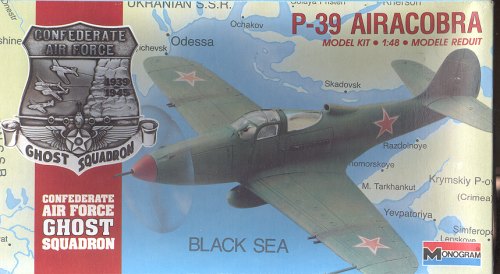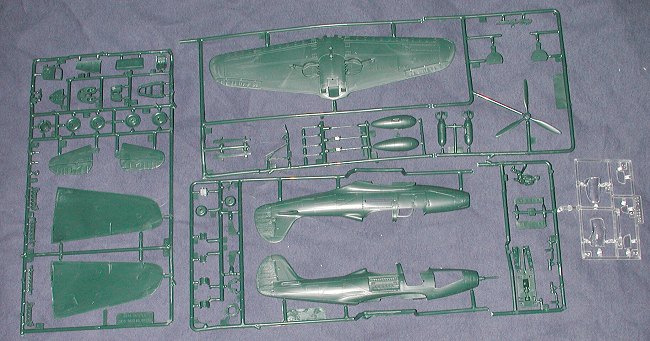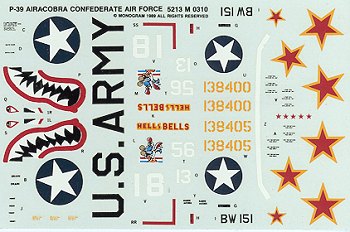
|
KIT: |
Monogram 1/48 P-39 Airacobra |
|
KIT # |
5213 |
|
PRICE: |
? |
|
DECALS: |
4 options |
|
REVIEWER: |
|
|
NOTES: |
1989 boxing |

|
HISTORY |
The P-39 was one of America's first-line pursuit planes in December 1941. It made its initial flight in April 1939 at Wright Field and by the time of the Pearl Harbor attack, nearly 600 had been built. Its unique engine location behind the cockpit caused some pilot concern, but this proved to be no more of a hazard in a crash landing than with an engine located forward of the cockpit. However, the P-39's spin characteristics could be quite a problem if recovery techniques were ignored.
The Airacobra saw combat throughout the world, particularly in the Southwest Pacific, Mediterranean and Russian theaters. Because its engine was not equipped with a supercharger, the P-39 performed best below 17,000 feet altitude, and it often was used at lower altitudes for such missions as ground strafing. When P-39 production ended in August 1944, Bell had built 9,584 Airacobras, of which 4,773 had been allotted to the Soviet Union. Russian pilots particularly liked the cannon-armed P-39 for its ground attack capability. Other P-39s served French and British forces.
|
THE KIT |

Molded in a dark green plastic, this 1989 boxing is still nice and crisply molded. Raised panel lines are the norm, though that does not detract in any way from the quality of the molding. There are the usual ejector pin marks in the 'wrong' places (inside of doors, gear wells and such) as well as a few sink marks on a few of the thicker parts like the interior aft bulkhead and pilot figure. You'll note that the long sprues have been cut to fit into the smaller box than originally designed. Clear bits are well done though thicker than what we've come to expect.
The kit has a full interior and gun bay, complete with panels that can be removed to display the gun. Those of us who don't want a tail sitter will either have to fill this bay or be very creative with where to stash weight as there isn't much room. Another option is open doors and one also can show an engine half, should one wish to do so. Two styles of exhaust stacks, a 6 stack and 12 stack version are supplied in case one wishes to do a P-400. A drop tank or bomb is supplied for the belly rack. If doing a version with the shorter barreled nose cannon, one simply cuts off the portion not needed.
 Instructions are the usual Monogram sheets that are used
today. A color chart is provided with generic names of the colors followed
by 22 construction steps. Each step offers color information and the choice
of available options if they apply. There are markings for four aircraft
provided. One is the box art plane, a P-39L from the Soviet Air Force. No
unit or pilot is given. Next are two P-39Ds, one from the 67 FS/347 FG on
Guadalcanal in 1943. From Alaska is a 57 FS/54 FG P-39D. Both are rather
bland with little to distinguish them in terms of markings other than an
aircraft number and serial. Finally, a P-400 from the 67 FS/347 FG, also on
Guadalcanal in 1943. This is the one with the large sharkmouth. Decals are
fairly well printed, and glossy. They also have a registration
problem with the white not properly aligned with the other colors. It means
a new set of US insignia and a replacement of the 'shark mouth' at the
minimum. The Soviet markings appear unaffected. They look like they
should work quite well, should you decide to use them, as they do not
appear overly thick.
Instructions are the usual Monogram sheets that are used
today. A color chart is provided with generic names of the colors followed
by 22 construction steps. Each step offers color information and the choice
of available options if they apply. There are markings for four aircraft
provided. One is the box art plane, a P-39L from the Soviet Air Force. No
unit or pilot is given. Next are two P-39Ds, one from the 67 FS/347 FG on
Guadalcanal in 1943. From Alaska is a 57 FS/54 FG P-39D. Both are rather
bland with little to distinguish them in terms of markings other than an
aircraft number and serial. Finally, a P-400 from the 67 FS/347 FG, also on
Guadalcanal in 1943. This is the one with the large sharkmouth. Decals are
fairly well printed, and glossy. They also have a registration
problem with the white not properly aligned with the other colors. It means
a new set of US insignia and a replacement of the 'shark mouth' at the
minimum. The Soviet markings appear unaffected. They look like they
should work quite well, should you decide to use them, as they do not
appear overly thick.
|
CONCLUSIONS |
While not molded in the style of the newer Eduard kit, the Monogram P-39 is still a kit that makes into a super model. When one adds in the fact that it can be found for a quarter of what the Eduard kit retails, then it makes it a much more attractive prospect to the modeler on the budget.
If you would like your product reviewed fairly and quickly by a site that has over 200,000 visitors a month, please contact me or see other details in the Note to Contributors.